RESEARCH


Do not fill out this information.
On this particular page, the Initial Text and Image fields for this template are not used (inactive). A Carousel Slideshow is displayed instead.
To edit the Carousel Slideshow, Choose Edit Existing > Carousel Slides. Then navigate to your CZO's entry entitled "Research"
Overarching research question that guides CZO design
How does variability in climate, lithology and disturbance influence CZ structure and function over long (e.g., landscape evolution) and short (e.g., hydrologic event) time scales?
Goals of the Catalina-Jemez CZO
- Develop a cross-disciplinary, multi-scale, natural laboratory for collaborative observation and modeling.
- Measure the effects of climate, lithology, and disturbance variation on Critical Zone structure, function and evolution in the water-limited southwestern US.
- Focus on environmental gradients within regional watersheds.
- Develop a predictive-mechanistic understanding of how these systems affect environmental sustainability in a region of rapidly growing population growth and diminishing freshwater supplies.
Urban population growth throughout the southwestern US is sustained largely by water supplies that derive from upland catchments in nearby montane landscapes. Southwestern mountain belts in Southern Arizona, for example, which vary widely in lithology, are sometimes termed "Sky Islands" because their higher elevations receive more annual precipitation, support greater vegetation biomass and have higher rates of net primary production than the surrounding "sea" of desert semi-arid to arid landscape. Ecosystems and soil development at high elevations in the Southwest also support domestic forestry, range and recreation industries. Global climate models predict progressive warming and drying of the U.S. Southwest overall, and this is expected to affect the composition and health of ecosystems across the elevation range, e.g., through stress-induced disturbances such as insect outbreaks and wildfire.
Southwestern mountain systems are nonetheless expected to continue to serve as the water supply conduit to growing basin cities, in addition to supporting forestry, range and recreational activities. The need to understand their capacity to do so in the context of changing climate motivates Catalina-Jemez CZO research. The quantity and quality of water in upland catchments and receiving metropolitan areas depend on the processes that partition and transform it during its reactive transport through the CZ. However, the present-day hydrologic, geomorphic and (bio)geochemical behavior of the CZ depends, in turn, on its structure, which has evolved over geological time scales in response to long-term climatic and tectonic forcing. Therefore, a basic understanding of contemporary CZ behavior requires developing a conceptual model of how it has evolved to its current state, and how it will continue to evolve into the future. Such evolution includes the formation of hydrologic flow paths, the (bio)geochemical differentiation of the weathering profile, and the production and erosion of soil-mantled hillslopes. Our research involves field and laboratory based measurements in addition to computational modeling designed to understand how these processes are coupled over hydrologic event and landscape evolution time scales.
Research News
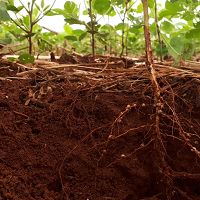
FEATURED NATIONALLY
NSF Blog: No soils, no life
27 Oct 2020 - They’re beneath our feet, but we seldom hear important signals in the soils

FEATURED NATIONALLY
2020 CZO Webinar Series on Sustainability
17 Jun 2020 - For an updated listing of these talks, including abstracts, see /national/education-outreach/sustainability-2020/ The U.S....

FEATURED
CZOs at AGU 2019
19 Nov 2019 - A list of CZ-related sessions, abstracts and events at the 2019 AGU Fall Meeting.

FEATURED
CZ colleagues: Please contact us about proposals for NSF’s CZ Collaborative Network, due 02 Dec 2019
08 Jul 2019 - CZO will end Nov 2020, succeeded by the “CZ Collaborative Network”. Let’s explore how the CZ community can build upon the CZOs via new NSF proposals.
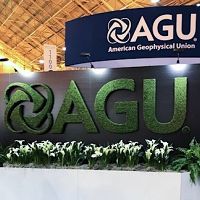
FEATURED
CZOs at AGU 2018
19 Nov 2018 - The 2018 AGU Fall Meeting will be held December 10-14 in Washington, D.C.

FEATURED
NSF Discovery articles focus on the CZOs.
10 May 2018 - The Discoveries section of the National Science Foundation's website on Critical Zone Observatories (CZOs).
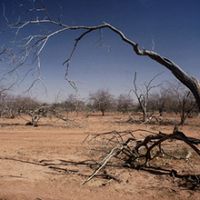
FEATURED
NSF News Release: What’s killing trees during droughts? Scientists have new answers.
14 Aug 2017 - Researchers find that carbon starvation and hydraulic failure kill drought-stricken trees.

FEATURED
AGU Horton Research Grant Award
03 Jul 2017 - Ravindra Dwivedi received the prestigious 2017 AGU Horton Research Grant to support his CZO work in the Santa Catalina Mountains.
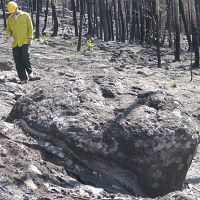
FEATURED
Post-Wildfire Erosion Can Sculpt Forested Mountains
19 Apr 2016 - Researchers from the UA Santa Catalina Mountains & Jemez River Basin Critical Zone Observatory did before-and-after studies of how severe...
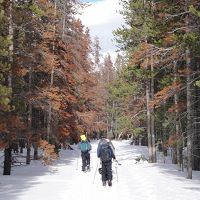
FEATURED
EOS: Bark Beetles Cause Big Tree Die-Offs, but Streams Flow Steadily
10 Mar 2016 - EOS article written by Lily Strelich features research conducted by CZO investigators and their colleagues, which shows that bark beetle epidemics...

FEATURED
The 2016 MG Anderson Award
03 Mar 2016 - The 2016 MG Anderson Award for Outstanding Paper in Hydrological Processes, Wiley is presented to Jemez-Catalina CZO investigators.

FEATURED
EOS Opinion: Understanding Ecosystem Services from a Geosciences Perspective
22 Jan 2016 - Assessment of ecosystem services can be improved by including broader spatial and temporal scales of geosciences perspectives.

FEATURED
Forests Worldwide Vulnerable to Drought, UA Researcher Says
28 Aug 2015 - David Breshears was interviewed by Sara Hammond about forest vulnerability to growing risks of drought and heat-induced die-off. Read and listen...
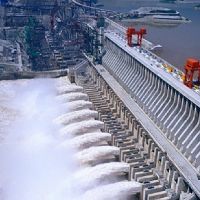
FEATURED
Jon Chorover to speak at international workshop on hydro-biogeochemical processes
16 Jul 2015 - Jon Chorover of the Santa Catalina Mountains & Jemez River Basin CZO has been invited to talk at the Hydro-Biogeochemical Processes: Mechanisms,...

FEATURED
Soil, Not Dirt: A Digital Journey Connecting Soils, Plants, and Climate by Rebecca Lybrand
08 Jun 2015 - Join Rebecca on an exciting GoPro adventure to study soil in the desert, grasslands, and pine forests of Arizona.

FEATURED
Critical Zone Profiles - Meet the people doing CZO science (Catalina-Jemez CZO)
19 Mar 2015 - Get a sense of the people and the work. Several members of the Catalina-Jemez CZO are profiled here, including students and professors.
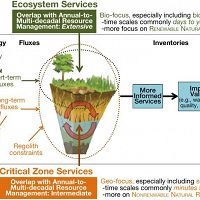
FEATURED
Critical Zone Services: Expanding Context, Constraints, and Currency beyond Ecosystem Services
10 Feb 2015 - Critical Zone Services: Expanding Context, Constraints, and Currency beyond Ecosystem Services
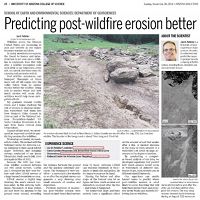
FEATURED
Predicting post-wildfire erosion better
08 Dec 2014 - Jon Pelletier and his graduate student Caitlin Orem's research on the post Las Conchas fire erosion was highlighed in the Arizona Daily Star...
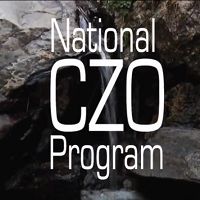
White paper of 2017 CZ Science Meeting in Arlington, VA
01 Jan 2018 - New Opportunities for Critical Zone Science Following the June 2017 Arlington Meeting for Critical Zone Science (hosted by CZO), a white booklet...

CZOs at AGU 2017
05 Dec 2017 - Information on CZO award recipients, events, presentations, etc. at the 2017 AGU Fall Meeting.
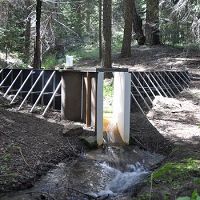
Water Resources Research Special Collection: Concentration-discharge relations in the critical zone
30 Oct 2017 - Water Resources Research published a new special collection in September 2017 featuring concentration-discharge research from multiple CZOs.

The frontier beneath our feet — an AGU commentary on the critical zone
21 Apr 2017 - AGU has published a collection of commentaries highlighting the important role Earth and space science research plays in society.

2017 CZO Webinar Series: Critical Zone and Society
06 Apr 2017 - 2017 CZO Webinar Series: Critical Zone and Society.
Example Publications
FEATURED NATIONALLY
Increasing plant water stress and decreasing summer streamflow in response to a warmer and wetter climate in seasonally snow‐covered forests. Christensen L., Adams HR, Tai X, Barnard HR, Brooks PD (2020): Ecohydrology e2256 (online) Cross-CZO
FEATURED
Montane forest productivity across a semiarid climatic gradient. Knowles J.F., Scott R.L., Biederman J.A., Blanken P.D., Burns S.P., Dore S., Kolb T.E., Litvak M.E., Barron‐Gafford G.A. (2020): Global Change Biology (online)
FEATURED
Topography influences species-specific patterns of seasonal primary productivity in a semiarid montane forest. Murphy P.C., Knowles J.F., Moore D.J.P., Anchukaitis K., Potts D.L., Barron-Gafford G.A. (2020): Tree Physiology 40(10): 1343–1354
FEATURED
Depth and topographic controls on microbial activity in a recently burned sub-alpine catchment. Fairbanks D., Shepard C., Murphy M., Rasmussen C., Chorover J., Rich V., Gallery R. (2020): Soil Biology and Biochemistry 148: 107844
FEATURED
Ecosystem carbon and water cycling from a sky island montane forest. Knowles J.F., Scott R.L., Minor R.L., Barron-Gafford G.A. (2020): Agricultural and Forest Meteorology 281: 107835
FEATURED
Ubiquitous Fractal Scaling and Filtering Behavior of Hydrologic Fluxes and Storages from A Mountain Headwater Catchment. Dwivedi R., Knowles J.F., Eastoe C., Minor R., Abramson N., Mitra B., Wright W.E., McIntosh J., Meixner T., Ferre P.A.T., Castro C., Niu G.-Y., Barron-Gafford G.A., Stanley M., and Chorover J. (2020): Water 12(2): 613
FEATURED
Critical Zone Biogeochemistry. Moravec, B. and Chorover, J. (2020): In Biogeochemical Cycles (eds K. Dontsova, Z. Balogh‐Brunstad and G. Le Roux)
FEATURED NATIONALLY
Where is the bottom of a watershed?. Condon L.E., Markovich K.H., Kelleher C.A., McDonnell J.J., Ferguson G., and McIntosh J.C. (2020): Water Resources Research 56(3): e2019WR026010
FEATURED
Vegetation source water identification using isotopic and hydrometric observations from a subhumid mountain catchment. Dwivedi R., Eastoe C., Knowles J.F., Wright W.E., Hamann L., Minor R., Mitra B., Meixner T., McIntosh J., Ferre P.A.T., Castro C., Niu G.-Y., Barron‐Gafford G.A., Abramson N., Papuga S.A., Stanley M., Hu J., Chorover J. (2020): Ecohydrology 13(1): e2167
FEATURED NATIONALLY
Resolving Deep Critical Zone Architecture in Complex Volcanic Terrain. Moravec B.G., White A.M., Root R.A, Sanchez A., Olshansky Y., Paras B.K., Carr B., McIntosh J., Pelletier J.D., Rasmussen C., Holbrook W.S., Chorover J. (2020): Journal of Geophysical Research: Earth Surface 125(1): e2019JF005189 Cross-CZO
FEATURED
Critical Zone Science in the Anthropocene: Opportunities for biogeographic and ecological theory and praxis to drive earth science integration. Minor J., Pearl J.K., Barnes M.L., Colella T.R., Murphy P.C., Mann S., Barron-Gafford G.A. (2020): Progress in Physical Geography: Earth and Environment 44(1): 50–69
FEATURED
Ecological and genomic attributes of novel bacterial taxa that thrive in subsurface soil horizons. Brewer, Tess E., Emma L. Aronson, Keshav Arogyaswamy, Sharon A. Billings, Jon K. Botthoff, Ashley N. Campbell, Nicholas C. Dove, Dawson Fairbanks, Rachel E. Gallery, Stephen C. Hart, Jason Kaye, Gary King, Geoffrey Logan, Kathleen A. Lohse, Mia R. Maltz, Emilio Mayorga, Caitlin O’Neill, Sarah M. Owens, Aaron Packman, Jennifer Pett-Ridge, Alain F. Plante, Daniel D. Richter, Whendee L. Silver, Wendy H. Yang, Noah Fierer (2019): mBio Oct 2019, 10 (5) e01318-19 Cross-CZO National
FEATURED
Prevalence and magnitude of groundwater use by vegetation: a global stable isotope meta-analysis. Jaivime Evaristo and Jeffrey J. McDonnell (2017): Scientific Reports 7 Cross-CZO National
Targeting Extreme Events: Complementing Near-Term Ecological Forecasting With Rapid Experiments and Regional Surveys. Redmond M.D., Law D.J., Field J.P., Meneses N., Carroll C.J.W., Wion A.P., Breshears D.D., Cobb N.S., Dietze M.C. and Gallery R.E. (2019): Frontiers in Environmental Science 7: 183
Mountain‐Block Recharge: A Review of Current Understanding. Markovich K.H, Manning A.H., Condon L.E., McIntosh J.C. (2019): Water Resources Research 55(11): 8278-8304
Allometric relationships for Quercus gambelii and Robinia neomexicana for biomass estimation following disturbance. Krofcheck D.J., Litvak M.E., Hurteau M.D. (2019): Ecosphere 10(10): e02905
Distinct stores and the routing of water in the deep critical zone of a snow-dominated volcanic catchment. White A., Moravec B., McIntosh J., Olshansky Y., Paras B., Sanchez R.A., Ferré T.P.A., Meixner T., and Chorover J. (2019): Hydrology and Earth System Sciences 23(11): 4661-4683
Soil Fluid Biogeochemical Response to Climatic Events. Olshansky Y., Knowles J.F., Barron‐Gafford G.A., Rasmussen C., Abramson N., Chorover J. (2019): Journal of Geophysical Research: Biogeosciences 124(9): 2866-2882
Ecosystem-bedrock interaction changes nutrient compartmentalization during early oxidative weathering. Zaharescu D.G., Burghelea C.I., Dontsova K., Presler J.K., Hunt E.A., Domanik K.J., Amistadi M.K., Sandhaus S., Munoz E.N., Gaddis E.E., Galey M., Vaquera-Ibarra M.O., Palacios-Menendez M.A., Castrejón-Martinez R., Roldán-Nicolau E.C., Li K., Maier R.M., Reinhard C.T., Chorover J. (2019): Scientific Reports 9: 15006
A correlative bimodal surface imaging method to assess hyphae-rock interactions. Qafoku, Odeta, Rebecca A. Lybrand, Vaithiyalingam Shutthanandan, Rachel E. Gallery, Jason C. Austin, Paul A. Schroeder, Jennifer Fedenko, Erin Rooney, and Dragos G. Zaharescu (2019): Microscopy and Microanalysis, 25(S2), 2436-2437 Cross-CZO
Explore Further




_76_76_80auto_s_c1.jpg)
